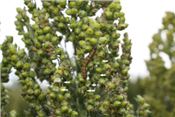Steps For Managing Insects In Grain Sorghum

Corn earworm and feeding injury
DR. SCOTT STEWART
JACKSON, TENN.
With a substantial increase in sorghum acres, there are a lot of questions about managing insect pests. Sorghum will typically require more insect management then corn, especially in the Bt corn era. This means we are more likely to need one or more foliar insecticide applications. Below are some steps you should be thinking about for managing insects in grain sorghum.
Step 1 – Plant early but in conditions where uniform emergence is expected. This step, when possible, greatly decreases your chances of having serious infestations of sorghum midge, whorl feeding infestations of fall armyworm, and ‘headworms’ like fall armyworm and corn earworm. Although a new pest, I expect that sugarcane aphids are far less likely to cause serious problems in early planted milo.
Step 2 – Scout or hire a professional crop consultant. Scouting is especially critical for the 2-3 weeks during flowering and early grain development. This is the time when sorghum midge and headworm infestations may cause economic damage. Scouting is more important than ever with the unknowns associated with potential sugarcane aphid infestations. Sorghum can be itchy but not a particularly difficult crop to scout, and tips will be provided in future articles. Once a week sampling is usually sufficient unless sugarcane aphid are present. I suggest a tighter schedule when aphids are present because populations can grow rapidly. I also suggest scouting every 4-5 days for sorghum midge and headworms during the two weeks of mid bloom and early grain fill.
Step 3 – Consider using an insecticide seed treatment. They come as a standard treatment from some seed companies. There are several potential advantages of using neonicotinoid seed treatments like Cruiser (thiamethoxam) or Poncho (clothianidin). Greenbugs are not a common problem in Tennessee, but sorghum seedlings are especially sensitive to infestations by this aphid. Insecticide seed treatments will typically protect seedling plants for 30-40 days, getting them past their most sensitive stage. These same seed treatments appear to provide similar protection against early infestations of sugarcane aphids, and this could be especially important in later planted sorghum. Insecticide seed treatments will also protect plants against other seedling pests that sometimes occur.
Step 4 – Maintain good weed control and be aware of your surroundings. Johnsongrass in is a source of sorghum midge and sugarcane infestations in milo. Besides Johnsongrass, an important source of sorghum midge infestations is earlier maturing sorghum fields in the vicinity of later planted field. Sorghum midge populations can build in early sorghum and the next, much larger generation will move to nearby fields. Replanted or delayed spots within the same field can be hit hard by midge infestations originating from earlier maturing areas. This is why getting uniform emergence is an important step. Economically damaging infestation are sorghum midge uncommon in early planted fields with uniform head emergence.
Step 5 – Make timely applications with the right insecticide(s). This requires information about pest populations and insecticide options. Recommended treatment thresholds and insecticide options for common pests are listed in UT’s insect control recommendations for sorghum. Below are some common choices for the major pests.
• Sorghum Midge – Pyrethroid insecticides like Baythroid XL, Declare, Karate/Warrior and Mustang Max at mid rates are commonly used, economical, and effective. Note that products containing bifenthrin such as Brigade are not labeled in milo. Lorsban, other chlorpyrifos products, or chlorpyrifos premixes such as Cobalt Advanced and Stallion are also options. Sugarcane aphids are a wrench in the works. Pyrethroid insecticides will potentially flare infestations of this pest by eliminating beneficial insects. The chlorpyrifos options may provide some control of sugarcane aphids. They have not provided consistent control in insecticide trials, but Lorsban may be less likely to flare aphid infestations than a pyrethroid. The bottom line is don’t’ make an application for sorghum midge unless you have a problem.
• Sugarcane Aphid – There are only two products I would recommend with much confidence. Transform WG (section 18 pending) at 1-1.5 oz/acre and Sivanto at 5-7.5 oz/acre appear to be the best available options. Keep in mind we are still learning about this pest. High rates of Lorsban Advanced (24-32 oz/acre) have provided acceptable control in some tests (but not others), and the pre-harvest interval restriction pretty much prevents the use of these higher rates once heads have emerged.
• Fall Armyworm and Corn Earworm – Headworm infestations vary considerably from field to field. Corn earworm is the most common species we deal with, but fall armyworm are not uncommon in late planted sorghum. Traditionally, we have used pyrethroid insecticides with good effect. However, pyrethroids are not as effective as they once were. They may provide adequate control of moderate corn earworm infestations, but our testing as indicated superior control with the diamide class of chemistry, especially Prevathon or Besiege. These products are probably a worthwhile investment where heavy pressure is expected such as in late plantings. They provide substantial residual control and also control sorghum webworm.
A new product, Heligen, is a NPV virus that controls corn earworm (and corn earworm only). I’ve been impressed with this product in my limited testing on sorghum. It would be good to gain some experience with this product, at least on some acres. It is not expensive and may be an especially good and non-disruptive fit where sugarcane aphids are threatening. For best effect, it needs to be applied when the first small larva are being found. Once the virus gets cycling through the population, it provides continual control. CPS will be the exclusive provider of Heligen in 2015. ∆
DR. SCOTT STEWART: IPM Extension Specialist, University of Tennessee